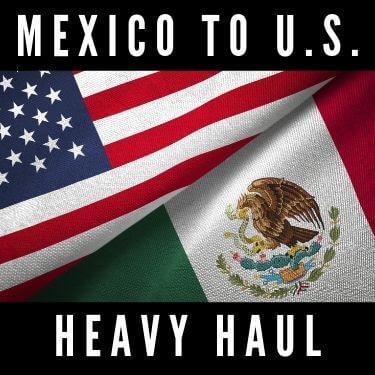
By
 Copy URL to Clipboard
Copy URL to Clipboard
Managing Mexico to US heavy haul shipments can be a stressful process. With so much that could go wrong, it’s understandable to feel confusion and pressure when shipping oversize goods across the border.
Key Takeaways
Join us to find out what’s involved in hauling heavy loads from Mexico to the U.S.
Table of Contents
Heavy haul, or “oversize” freight, is a classification used to describe any freight that exceeds the size and/or weight restrictions set by the DOT for standard freight.
Some examples of heavy haul freight are:
Aside from these common examples, anything can be considered a heavy haul if it does not conform to state and/or federal guidelines for standard shipping dimensions.
Related: Shipping Machinery From Mexico to USA
In most of the United States, a load is considered a heavy haul if it exceeds one more of the following dimensions:
| Width | 8’6” |
| Height | 13’6” |
| Length | 53’ |
| Weight | 80,000 lbs |
| Overhang | 3’ front, 4’ rear |
However, individual states determine the specific dimensions that qualify as oversized or heavy haul freight within their borders. Some are more relaxed than those of the FDOT.
The four border states of Arizona, California, New Mexico, and Texas, largely align with federal regulations, though Arizona does allow heights of up to 14’ on certain routes.
Regulations in Mexico allow for larger dimensions and weights than those in the U.S. before classifying cargo as oversize. I’ve laid them out in the table below. These are set by the Secretaría de Comunicaciones y Transportes (SCT). Unlike in the U.S., different states in Mexico cannot set their own individual standards.
| Width | 12’ |
| Height | 15.6’ |
| Length | 110’ |
| Weight | 125,000 lbs or max axle load, whichever is lower |
Hauling anything that exceeds these dimensions will require you to apply for a government-issued permit.
Obviously, the larger dimensions allowed by Mexican regulations are at odds with those stateside. To reduce traffic congestion from large shipments coming from Mexico to the U.S., certain states and ports have created special cross-border permit programs.
This is a commodity-specific permit for carriers bringing produce into Arizona from Mexico. It increases allowable load sizes from 80,000 lbs to 90,800 lbs. To qualify, these shipments have to be unloaded within one of the following commercial zones.
This program has proven successful at reducing congested traffic and enhancing security for incoming shipments of produce.
Related: Shipping Vegetables From Mexico to USA
Located in Texas, the Port of Brownsville issues permits to carriers bringing shipments that would be considered oversize by U.S. standards.
These allow limited transit from the Los Tomates port of entry in Matamoras, Mexico on the following routes:
Vehicles using these routes into the U.S. must not exceed the maximum hauling dimensions for freight within Mexico. When they reach the U.S., they are sent to a staging area and broken down into shipments that meet U.S. regulations before continuing to their final destinations. If the cargo can’t be broken down into smaller shipments, an oversize permit or permits will be required for further transit
Each state in the U.S. requires carriers of over-dimensional shipments to apply for special permits in order to travel within their borders. Therefore, if your shipment needs to travel through more than one state, you will need to apply for multiple permits.
Permit rates are determined by the frequency of their use. Although the most common is a single trip permit, there are also seasonal and annual options. Information on who to contact for information on each state can be found on the DOT’s Federal Highway Administration’s (FHWA) freight management and operations website.
Because of the difference in regulations from country to country and even state to state, most shippers choose to work with an experienced shipping and logistics company. This way, they can rest easy knowing that they will be compliant with all laws on both sides of the border.
It’s important to remember that hauling an oversize load takes longer than normal truckload transportation services.
Some reasons for this include:
To get an idea of how long the wait times are likely to be for your specific port of entry, you can use the Customs and Border Protection’s (CBP) Border Wait Times website.
In order to be allowed to run on normal roads, heavy haul trucks and trailers need to be outfitted with certain safety features.
In addition to using these high-visibility accessories, you may need to work in tandem with pilot vehicles while hauling oversize freight.
Some states require that heavy haul loads be accompanied by escorts or pilot vehicles. This is a precaution intended mostly for the safety of other drivers, informing them of the incoming oversized load and paving the way for the carrier to move through traffic safely.
If your shipment has to travel through multiple states, these requirements could become overwhelming. Instead of reaching out to all the different states for individual permits, consider partnering with a logistics company that has experience moving large cargo across the U.S./Mexico border. They can apply for all the necessary permits and ship your oversize goods efficiently.
R+L Global Logistics can help you manage your Mexico to US heavy haul by connecting you with trusted trucking companies, offering freight brokerage services, and finding the best possible rate for your shipment.
Additionally, we offer:
Call us today at (866) 335-0495 or submit a contact form online. No shipment is too large for Mexico Cross Border Freight.
 Copy URL to Clipboard
Copy URL to Clipboard

Interested in possibly teaming up on a heavy haul Mex-US heavy haul project.